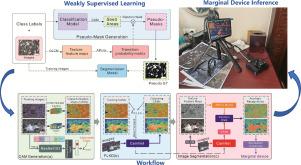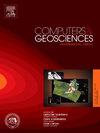Weakly supervised semantic segmentation of microscopic carbonates on marginal devices
IF 4.4
2区 地球科学
Q1 COMPUTER SCIENCE, INTERDISCIPLINARY APPLICATIONS
引用次数: 0
Abstract
Microscopic analysis is the cornerstone to uncover petrological and mineralogical characteristics of carbonate rocks. In addition, such information is critical for precise identification of carbonate microfacies and diagenetic evolution. This type of information is important, but relies too much on manual experience, which is time-consuming and laborious. Recently, several successful deep learning models showed great potential in the identification process. However, current deep learning models have typically complex model architectures greatly hinder the deployment-inference in practical and lightweight environments. To overcome the difficulty of deep learning models in reasoning in actual edge scenes, a three-stage segmentation method by weakly supervised learning was proposed. The approach embeds class activation mapping (CAM), grey level co-occurrence matrix (GLCM), and knowledge distillation (KD) modules to achieve attention transfer to the lightweight network (CamNet). Furthermore, based on the performance of the model algorithm and application requirements, a lightweight carbonate thin section image-assistant recognition system has been developed. Through ingenious control flow design, this system achieves an effective balance between runtime latency and resource consumption, demonstrating superior performance metrics. Experimental results indicate that CamNet’s total parameter count is only 800k. When deployed in embedded systems, CamNet achieves an inference speed of 6.87 fps. Our successful development verifies the efficiency and practicality in marginal devices.

微碳酸盐在边缘装置上的弱监督语义分割
微观分析是揭示碳酸盐岩岩石矿物学特征的基石。此外,这些信息对于精确识别碳酸盐岩微相和成岩演化具有重要意义。这种类型的信息很重要,但过于依赖于人工经验,这既耗时又费力。最近,一些成功的深度学习模型在识别过程中显示出巨大的潜力。然而,当前的深度学习模型通常具有复杂的模型架构,这极大地阻碍了在实际和轻量级环境中的部署推理。为了克服深度学习模型在实际边缘场景中的推理困难,提出了一种基于弱监督学习的三阶段分割方法。该方法通过嵌入类激活映射(CAM)、灰度共生矩阵(GLCM)和知识蒸馏(KD)模块来实现对轻量级网络(CamNet)的注意力转移。在此基础上,根据模型算法的性能和应用需求,开发了轻质碳酸盐薄壁图像辅助识别系统。通过巧妙的控制流设计,该系统实现了运行时延迟和资源消耗之间的有效平衡,展示了卓越的性能指标。实验结果表明,CamNet的总参数数仅为800k。在嵌入式系统中部署时,CamNet的推理速度为6.87 fps。我们的成功开发验证了边际装置的效率和实用性。
本文章由计算机程序翻译,如有差异,请以英文原文为准。
求助全文
约1分钟内获得全文
求助全文
来源期刊

Computers & Geosciences
地学-地球科学综合
CiteScore
9.30
自引率
6.80%
发文量
164
审稿时长
3.4 months
期刊介绍:
Computers & Geosciences publishes high impact, original research at the interface between Computer Sciences and Geosciences. Publications should apply modern computer science paradigms, whether computational or informatics-based, to address problems in the geosciences.
 求助内容:
求助内容: 应助结果提醒方式:
应助结果提醒方式:


